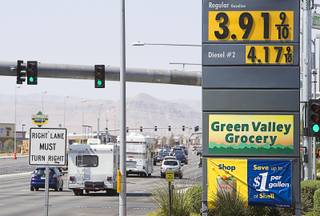
Wally Haim of Chicago fills up his car on Las Vegas Boulevard South Thursday, April 14, 2011.
Thursday, April 14, 2011 | 8:04 p.m.
Local gas prices
Beyond the Sun
Gas prices
The average price for a gallon of gas in Nevada for the past 12 months, according to AAA's monthly report:
April 2011: $3.87
March 2011: $3.62
February 2011: $3.16
January 2011: $3.12
December 2010: $3.07
November 2010: $2.94
October 2010: $2.89
September 2010: $2.84
August 2010: $2.97
July 2010: $2.93
June 2010: $2.88
May 2010: $3.00
Sun archives
- Gas prices continue upward march in Las Vegas (4-12-2011)
- Will rising gas prices pinch Las Vegas tourism? (3-5-2011)
Derek Randolph got a rude send-off from Las Vegas after spending a week here with his wife.
The two made a quick stop Thursday morning at the ARCO gas station across Las Vegas Boulevard from the Luxor to fill up their rental car before returning it and flying home to Minnesota.
The price listed on the pump: $3.85 for regular and $4.07 for the premium to fill Randolph’s rented Corvette convertible.
Randolph said the price of gas means he is “absolutely” cutting back on spending in other areas, such as trips to Las Vegas. “We travel a lot, and it definitely puts a damper on things,” he said.
In the past month, the average price of gas in Las Vegas has gone up 20 cents.
In the same time period, traffic on Interstate 15 at the Nevada-California state line fell 4.2 percent compared to last year.
That’s the largest decline in traffic between Southern Nevada and Southern California in two years, according to data from the Nevada Department of Transportation.
Gas prices in both places have continued to rise, with a gallon of gas averaging $3.85 in Las Vegas and $4.19 in Los Angeles.
Typically, March is a busy month for Las Vegas, with spring break and March Madness combining with good weather and the re-opening of pool clubs to fill resorts and casinos.
March 2008 — three months before Las Vegas hit record high gas prices — was actually the busiest month that year, according to data from the Las Vegas Convention and Visitors Authority, and traffic on I-15 that month averaged more than 1,000 more cars per day than the road saw last month.
The LVCVA won’t release its March visitor report until May, but in February, officials said they didn’t think gas prices would impact visitor numbers.
Traffic counts on I-15 suggest otherwise, and the news is especially discouraging because it seemed like the economy was improving.
So far this year, McCarran International Airport has seen an increase in passengers, but more than 60 percent of visitors to Las Vegas get here by car, so an increase in gas prices could turn the recovery back.
“People have just started to come back to Las Vegas and there have been hints that the economy is starting to turn around, then we get hit with theses extraordinarily high gas prices,” said AAA spokesman Michael Geeser, who monitors gas prices and travel trends. “The peak summer travel season might not have much of a peak this year.”
Las Vegas’ reliance on drive-in traffic from Southern California doesn’t help, as the region has some of the highest gas prices in the nation.
Gas prices in Los Angeles have increased nearly $1.10 in the past year, making Las Vegas’ 94-cent increase look mild.
In the last two weeks, national consumer demand for gasoline has fallen, indicating people everywhere are cutting back, Geeser said.
“We’re at the threshold, as people start to drive less as the prices hit them in the pocket,” Geeser said.
Price increases aren’t expected to subside soon, but Geeser is hesitant to say for sure that Las Vegas gas prices will pass their historical high of $4.28 set in June 2008.
“We still have some 40-cents it would have to climb, and most people expect prices to level off in mid-July, so it’s kind of a guessing game if we’ll get there,” he said.
Gas prices typically drop on the late summer, but with turmoil in the Middle East, prices may continue going up, Geeser said.
It’s not just tourists who are reacting to the higher gas prices. Locals appear to be making more use of carpools and using public transportation.
More than 500 people signed up for the Regional Transportation Commission’s Club Ride program last month, a 30 percent increase over a typical month.
Participants in the program, which offers incentives for people who carpool and use alternative forms of transportation, reported making 45,986 carpool trips in March, an 11 percent increase from February.
Even more telling: 747 new people called the commission asking to be matched with a carpool partner, a 69 percent increase over February.
The commission also said the number of people using its bus system is on the rise, although exact numbers for March aren’t yet available.
“When gas prices increase, we typically see that our customers choose to leave behind their personal vehicles more often and ride transit, carpool with family, friends or co-workers, walk or bike in an effort to save money and spend less at the gas pump,” said RTC spokeswoman Angela Torres.
Torres said it costs the average commuter $13 per day to drive to and from work. Carpooling or using public transit can easily cut that price in half, she said.
The American Public Transportation Association released a report Thursday claiming that people can save even more by ditching their cars.
The average Las Vegans living in a two-person household would save an average of $780 per month — as much as $9,361 per year — by taking public transit and only having one car, the report said.


Join the Discussion:
Check this out for a full explanation of our conversion to the LiveFyre commenting system and instructions on how to sign up for an account.
Full comments policy